PARISH OF DROMARA
by Dean Anthony Davies
The village of Dromara nestles at the foot of the
Dromara Mountains, from whose northern slopes the River Lagan takes its
rise. It is a quiet place not well known to travellers, yet conveniently
situated. Belfast is within twenty miles and it is ringed by the city of
Lisburn and the thriving towns of Dromore, Banbridge, Rathfriland and
Ballynahinch, with Castlewellan over the mountains and Newcastle a few
miles beyond.
There are 14 townlands making up the parish of
Dromara:
Aughnaskeagh � Field of the whitehorn.
Artana � High ground.
Begney � Small glebe.
Crossgare � Short cross.
Derry -- Oak grove.
Dree � Townland of the portion.
Drinn � same as Dree (two halves of a townland).
Dromara � Hill ridge of the heifers.
Drumadoney -- Sunday's hill.
Finnis � Wooden island.
Gransha � Granary.
Levallyreagh � Grey half townland.
Moybrick � Plain of the wild pig.
Moydalgan � Plain of the briars.

The village was described as follows by Lewis'
Topographical History in 1837: "Dromeragh, a small village, partly
in the barony of Kinelearty, partly in Lower Iveagh and chiefly in Upper
Iveagh. It contains part of the lands granted by patent of Queen
Elizabeth in 1585 to Ever Mac Rory Magennis which was forfeited in the
war of 1641 and afterwards granted by King Charles II to Colonel Hill.
They were included in the Manor of Kilwarlin.
The church of Dromara probably began as an offshoot
of the church and monastery of Drornore. In the 6th-10th centuries, the
Church in Ireland was organised on monastic lines. There were no
parishes as such and each area was administered spiritually from the
local monastery. It is assumed that the church of Dromara was sited on
the banks of the River Lagan at or near the spot where the Church of
Ireland, St. John's Church, stands. The original church, with probably a
small monastic settlement, may have stood within the graveyard where
there is in part a semicircular rampart. Early churches were often
erected with such a circular rampart.
Two conditions for Irish foundations, however small,
were i) to be located in good pasture land, and ii) near an abundant
supply of water. These two conditions existed here. In fact the good
quality of pasture is evidenced by the very name Dromara, from the Irish
`Droim Bearach' - the hill of the heifers.
As time went on the monastic organisation of the
Irish Church changed and parishes, more or less as we know them today,
were formed. This development resulted from the decisions reached at a
number of National Synods held in Ireland in the 12th century. The first
written reference to Dromara occurs in the official Ecclesiastical
Taxation document of 1306. A list of all parishes in the diocese was
included and Dromara parish was referred to as the `Church of Drumberra.'
EARLY PRIESTS OF THE PARISH
From around this time onwards, some names of the
priests of the parish begin to appear in various church records. The
first priest mentioned is Gilbert Mac Inerney who was Vicar (i.e.
Curate of the parish), 1427-40.
John McStay was Rector (i.e. Parish Priest)
in 1441.
William Rooney, Vicar in 1460.
Peter Rooney, Rector, 1529.
Thomas McCormack, Rector, 1539.
From another source we find this account of the Rectors
of Dromara.
John O Mustegs, Rector of Dromara. Ordained Deacon
on 24th. February and Priest on the 7th. March 1441. This is
probably the John McStay on previous list.
Marcus Maginn.
William Rooney, 1st. March 1504 (could this be the same
William who, in the previous list, was Vicar in 1460?).
Peter O'Rooney, 14th. December, 1529.
Patrick Maginn, 1530.
Arthur O'Rooney, then Vicar of Drumgooland on 12th. March
1530.
Patrick Maginn, (likely the same Patrick as above).
Dermot McStay.
Thomas McCormick, Dean of Dromore on 24th. May 1539.

There followed a gap of 165 years in the records
which can be explained by the turmoil of the years following the
Reformation. During the Penal Days, Dromara and Magheradroll were
united. We are aware of one Mass Rock within the parish, from this
period. It was situated in the townland of Drinn, located on Rogan's
farm.
The earliest record of priests of Dromara parish,
following the Reformation, is in 1704. Fr. Darby McKay was a
native of Levallyreagh, where he lived in the parental house. He was
registered as P.P. of Dromara and Magheradroll, at Downpatrick, on 11th.
July 1704 and was 56 years of age. Fr. McKay was ordained by Dr. Patrick
Plunkett, Bishop of Ardagh, in 1682 and died in 1762, in Levallyreagh.
During the Penal Times many priests registered.
In a report by the Protestant bishop to the House of
Lords in 1731, both Dromara and Magheradroll are recorded as having only
one priest. According to O'Laverty's History of Down and
Connor, the curate of Magheradroll at that time was Fr. Patrick
Dugan. It would seem to be a correct assumption, therefore, that he
was the priest in Dromara, in 1731, to whom the Protestant bishop was
referring. The country during the Cromwellian era was in a very
unsettled state and records would have been somewhat sketchy. Documents
now in the archives of Propaganda Fide state the following:-
Fr. Dan O'Fegan was appointed P.P. of Dromara
and Magheradroll on 23rd. September 1741 and, on 12th. September 1766,
was appointed as R.P. of Dromara. In 1776, Fr. Pulleine was
recorded as P.P. Dromara. Fr. Francis McKenny was P.P. of Dromara
and Magheradroll from 1731-1788. He became Vicar General of the diocese
and was a native of Dromara. He died in 1788 and was interred in the
cemetery attached to St. John's Church, Dromara, which was formerly in
Catholic hands. A tombstone which previously marked his grave, and that
of another priest named McKenny, is not now visible. Following the death
of Fr. McKenny the union of the two parishes was dissolved and they
remained apart until 23rd. August 2002 when, as will be reported later
in our article, Dromara began to be served by the clergy of Magheradroll
Parish.
|
1793-1796 |
Rev. Daniel Mooney, P.P. At a meeting of
all denominations in Dromara on 26th. February 1796, to
consider the disturbances in Counties Down and Armagh,
tribute was paid to Fr. Mooney's "unremitting exertions to
preserve peace and regularity within the parish." |
|
1796-1826 |
Rev. Francis Reavey, P.P. after Fr.
Mooney's death. He erected the church at Finnis in 1825 and
died in 1826. |
|
1826-1829 |
Rev. Peter Murphy P.P. |
|
1829-1836 |
Rev. John McCartan P.P. He was born in Ryan
in the parish of Saval. He retired from Dromara in 1836 and
died as pastor in Nova Scotia. |
| 1836-1838 |
Rev. Thomas Brady, temporary administrator. |
|
1838-1850 |
Rev. Peter Devlin P.P. He was born in
Clonduff parish. Was appointed Vicar General in October 1844
and died at Dromara on 3rd June 1850. |
| 1850-1885 |
Rev. John Irwin P.P. He was born in
Loughall, Co Armagh. He was appointed principal of the
Diocesan Seminary, Newry, in 1842. He was appointed Vicar
General in 1878 and died on 7th. December 1885. |
|
1885-1903 |
Rev. Daniel Mallon P.P. appointed
administrator on 1844. |
|
1903-1907 |
Rev. John O'Hare P.P. A native of
Donaghmore parish. He was twice driven from the Parochial
House which he had built in Dromore by loyalist mobs during
the later years of his pastorate. In September 1920 he
became Parish Priest of Seagoe. |
|
1907-1920 |
Rev. John Savage P.P. He was born in
Lisburn. He ministered in Birmingham for three years. He
died on 30th. March 1920. |
|
1920-1933 |
Rev. Peter McEvoy P.P. He was born in the
parish of Lower Drumgooland. He was a prominent worker in
the Gaelic revival movement in the North and was a personal
friend of Mr. De Valera. He died on 7th. July 1939. |
|
1933-1958 |
Rev. Edward McConville P.P. He was born in
the parish of Drumgath. He was an uncle of Fr. Tom
McConville, Rathfriland. He resigned on 8th. October 1958
and died in Dublin on 19th. March 1972. He was buried in
Dromara on 21st. March 1972. |
|
1958-1967 |
Rev. Alex McMullan P.P. |
| 1967-1972 |
Rev. Michael O'Rourke P.P. |
|
1972-1990 |
Rev. Bernard Treanor P.P. A native of
Burren, he was an accomplished Irish Scholar and was
awarded, during his time in Maynooth, a B.A. in Celtic
Studies. He had a genuine love and enthusiasm for the Irish
language throughout his life. Gifted with an excellent
memory, he was a keen student of Irish History, especially
local history, and was a recognized authority on Irish
placenames. He was one of the founder members of the Dromore
Diocesan Historical Society and was editor of its Journal. |
|
1990-1995 |
Rev. Anthony Davies P.P. A native of
Tandragee, Co. Armagh. He was ordained for the Australian
Mission, for the Diocese of Bathurst. He was incardinated
into the Dromore Diocese on 29th. April 1962 and was
transferred to Clonduff on 8th. September 1995. |
|
1995-2002 |
Rev. Oliver Mooney P.P. A native of Newry,
he was educated at St. Kieran's College, Kilkenny and
ordained in Newry Cathedral on 7th. June 1970, for the
Diocese of Dromore. |

CURATES OF DROMARA
1783-1869
|
| 1783:- |
Rev. Andrew Murnin |
| 1783:- |
Rev. Daniel Mooney,
later P.P. |
| 1837-1838:- |
Rev. Michael Maginn |
| 1838-1839:- |
Rev. John Cunningham |
| 1839:- |
Rev. Thomas Ryan,
(27th. February) |
| 1839-1841:- |
Rev. John Callan |
| 1841-1844:- |
Rev. Terence Fegan |
| 1844-1845:- |
Rev. John Byrne |
| 1845-1850:- |
Rev. John Irwin,
appointed PP. |
| 1851-1853:- |
Rev. Andrew Brennan,
(17th. November 1851) |
| 1853-1856:- |
Rev. James McKenna,
(20th. August 1853) |
| 1856-1857:- |
Rev. Hugh Mooney,
(5th. October 1856) |
| 1857-1860:- |
Rev. Charles Kenny |
| 1860-1861:- |
Rev. Michael King |
| 1868-1869:- |
Rev. Mathew Lynch,
(8th. August 1868) |
| 1869-1870:- |
Rev. Thomas Gallery,
(1st. July 1869) |
| 1870-1871:- |
Rev. Patrick Quail |
| 1872-1875:- |
Rev. Charles McKey |
| 1876-1881:- |
Rev. Murtagh McPolin |
| 1882-1886:- |
Rev. Henry Devlin |
| 1886-1891:- |
Rev. Daniel Grant |
| 1895:- |
Rev. John McAllister |
| 1895-1898:- |
Rev. Thomas McGrath |
| 1899:- |
Rev. John J. Burns |
| There was no curate
in Dromara from 1899 to 1915. |
| 1915-1916:- |
Rev. Michael O'Neill |
| 1918-1922:- |
Rev. James McCorry |
| 1922-1931:- |
Rev. Patrick
McCartan |
| 1931-1933:- |
Rev. Edward Arthur
Smyth |

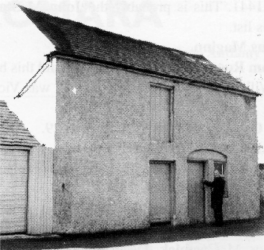
The late Canon Bernard Treanor, P.P., at
the entrance of what was formerly a small chapel used by the
Dromara people prior to the construction of the present
church. This building is found to the rear of the Parochial
House at Finnis.
From 1933, the parish of Dromara was served by the
parish priest alone. However on 23rd. August 2002, due to the shortage
of priests, the parishes of Dromara and Magheradroll were once again
paired and a curate was appointed to Dromara in the person of Fr. Paddy
Reedy, (Holy Ghost Fathers). Fr. Paddy had worked in the parish of
Drumgath from August 1993 to July 1997, when he was called to become
Rev. Superior of Rockwell College, Co. Tipperary. He returned to the
Diocese of Dromore on 10th. October 2003 and took up residence in the
Parochial House in Dromara. Fr. Reedy was appointed to Seapatrick parish
in August 2004.
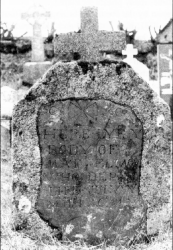
The oldest legible tombstone in
the cemetery at Finnis today. It remembers Mathew
Flynn who died in 1767.

THE CHURCH OF ST. MICHAEL,
DROMARA
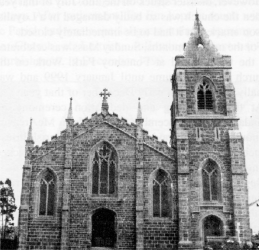
The Church of St. Michael The Archangel,
Dromara. The church appears to have been originally known as
the church of the `Sacred Heart'. This title is engraved on
the church bell.
The Church of St. Michael, Dromara, is a rectangular
building in dressed stone, standing impressively on a hill overlooking
the Dromara to Rathfriland Road. The freestone is said to have been
quarried beside the Lagan River, in the townland of Dree, just a few
hundred yards upstream from the church site. The facade of the church is
surmounted by granite pinnacles. An ornamental granite plinth rises to a
granite Cross in the centre, on which is cut the date 1835 in Roman
numerals. The church was designed by Thomas Duff, Newry, a well-known
architect of that time who also designed Newry Cathedral. The erection
of the church began in 1825. It was completed and dedicated by Most Rev.
Dr. Blake in 1835.
A former small chapel was located to the rear of the
Parochial House. The church was re-roofed and redecorated by Rev. D.
Mallon P.P. in 1887. However, it should be noted that the church was
then known as the `Church of the Sacred Heart' and an old survey map
give the church this name. This name and the date, A.D.1886, are
engraved on the church bell and the centre window has a picture of the
Sacred Heart. It is not certain when or why the church name was changed
to its present name of `St. Michael', though it has been suggested that
all churches built on hills were rededicated to St. Michael the
Archangel.

This beautiful mosaic, a replica of Da
Vinci's 'Last Supper', is one of four distinctive murals
adorning St. Michael's Church since 1911.
In 1855, a sermon was preached on 4th. March by Dr.
Leahy in Dromara church in order to defray the expenses of renovations
which had been carried out. The church was re-plastered internally and
the north and south walls were newly plastered, externally, from top to
bottom in 1983. In 1984, a new floor was laid in the church and the
building was re-wired and re-decorated. Further renovations were carried
out in the late 1990s.
The outstanding points of interest are the four mural
panels in the sanctuary, erected in 1911. These seem to have been the
personal gift of the P.P. at that time. The four panels, which are on
coloured opal glass which has been painted and fixed, portray the
Archangels Michael and Raphael and a Nazareth Scene.
The fourth panel, which is a mosaic of opal glass
with a gilt background, is a very beautiful replica of Leonardo Da
Vinci's `Last Supper.' The backing of this latter panel deteriorated and
the picture had to be remounted and re-stored in 1983 at a cost of
almost �3000. The restoration was the gift of a local family and this is
recorded on a plaque under the mural.
Further renovations were carried out on St.
Michael's, Dromara. An outside toilet block was erected in 1993. A
shrine to Our Lady Of Lourdes was erected at the back of the church as a
gift from the late Barney O' Hare, in 1996. The church was re-roofed,
re-plastered and repainted in 1996. A new baptismal font and presider's
chair were installed and a new carpet was fitted around the altar at
this time.
The Catholic population of Dromara, today, is estimated
to be around 500 people.

The Parochial House at Finnis
was erected, during the pastorate of F Peter
Devlin, in 1840.

THE CEMETERY dates from the middle of the 18th.
century. The oldest legible stone remembers Mathew Flynn, who died in
1767. Up until about 1820 some Catholic families continued to bury their
dead in the cemetery of St. John's Church, Dromara. The cemetery was
levelled in 1959. New pathways and a new entrance were made in 1973.
SCHOOLS - The former school at Finnis went back
to 1844 and was demolished in 1980. The new school of St. Michael's was
formally opened and blessed on 24th. September 1964, at a cost of
�14,000. It was extended in 1971 at a cost of �26,000. Muninbane School,
which had stood since 1836, was closed in June 1964.
PAROCHIAL HOUSE - This was erected by Very Rev.
Peter Devlin P.P. V.G., in 1840 and extended by Rev. D. Mallon P.P.,
about 1890. It was structurally improved in 1934 and re-roofed in 1959.
Central
heating was installed in 1969, while water and
electric mains were laid in 1959. In 1974 a second bathroom and a new
set of stairs were erected.
PAROCHIAL HALL
The new St. Michael's Hall was formally opened and
blessed on Sunday 3rd. February 1980. The old green wooden hall, which
had stood since 1920, was demolished.
HISTORIES OF DROMARA
Church and Parish of St. Michael, Dromara,
by Rev. Canon Bernard Treanor, (1985).
The Parish of Dromara Ireland
by Rev. Samuel Ernest Long, (1979).
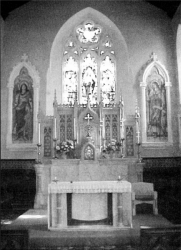
The Archangels, Michael, (left)
and Raphael keep vigil in the sanctuary of St.
Michael's, Finnis, today.
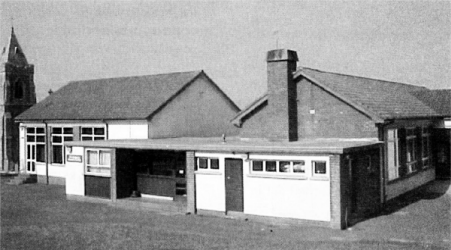
St. Michael's Primary School, in
the shadow of the parish church, has served the
community since its opening in September 1964.
 |